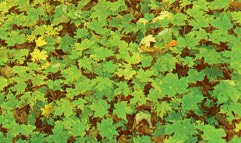
Shade tolerance is the relative capacity of tree species to compete for survival under shaded (which is to say, less-than-optimal) conditions. It is a tree trait, a functional adaptation that varies among species. Because of its outsized influence on tree survival and stand growth, shade tolerance is a pillar of silviculture.
Foresters everywhere commonly rank tree species on a continuum from very shade intolerant to very shade tolerant. These rankings of relative light requirements are a fundamental precept, a basis for a forester’s management decisions about which trees to keep or cut and when. In our region, forest tree growth is often limited more by lack of light than by lack of water, so understanding differences in shade tolerance of local tree species – and deftly employing them to grow nice trees – is among any forester’s very best tricks.
To fully enjoy how and why it works, keep in mind that shade tolerance is not the same as shade preference. Make no mistake, green plants prefer light. In fact, they require it. There’s no such thing as a shade-loving tree, it’s just that certain species can make do with less light. For these species, a bit of shade makes them more competitive than they would be under more light because they can outgrow less shade-tolerant species. They compete better in shade.
Shade-tolerant species, such as eastern hemlock and American beech, can scratch out a living on just 1 to 3 percent of full light. Typically, they have longer crowns with lower branches that stay foliated longer than intolerant species. They grow slowly and live long. By contrast, shade-intolerant species, such as trembling aspen and red pine, may require as much as 60 percent of full light to remain competitive. Typically, they have shorter, more open crowns, and grow in lower stand densities. They tend to mature early, fruit sooner, and die younger. There’s also a class of intermediate shade-tolerant species. Yellow birch and white pine, for instance, work the middle ranges of light availability, remaining competitive with 10 to 30 percent of full light. Many intermediates germinate and establish under the existing forest canopy, where they’ll wait until a local disturbance provides new light, at which point they can respond with accelerated growth to fill a gap in the canopy.
These are good, helpful generalities, but it is humbling to the forester to realize that shade tolerance is not necessarily always so simple and constant. Shade-tolerance definitely varies with the age of trees. Eastern white pine is one of many that is known to be significantly more shade tolerant as a seedling than it is as a mature tree. And shade tolerance can vary within a species across site types and regional climates. There’s also a genetic component.
If we dig a little deeper into the science of shade, we see that shade-tolerant trees are better than shade-intolerants at balancing photosynthesis and respiration under low light levels. Remember, photosynthesis is how plants make food. Respiration is the opposite; it’s how they consume food. The balance, or energy budget, determines survival. Shade-tolerants can capture and use low levels of light to make food without burning it all in the process. It’s not so much that they photosynthesize more under low light than shade-intolerant species do. Rather, shadetolerants seem to respire less. They don’t build solar cells they have no sun for. They’re thrifty. Over time they make more with less; it’s slow and steady to win the race.
Intolerants, on the other hand, are more the hare than the tortoise in this contest. They take a very different approach to light capture and use. They can photosynthesize and grow rapidly in full light, which enables them to outgrow the shade-tolerants in open conditions. But those high photosynthetic rates among intolerants are offset by similarly lavish rates of respiration. They are programmed to invest heavily in solar technology, as if light was never in short supply. With light aplenty, their investment pays off; just watch them outgrow their more shade-tolerant neighbors. But under shade, they cannot capture enough light to pay the costs and they cannot compete. Thus spendthrifty seedlings of shade-intolerant species languish in low light; whereas frugal seedlings of shade-tolerant species linger and last.


Discussion *